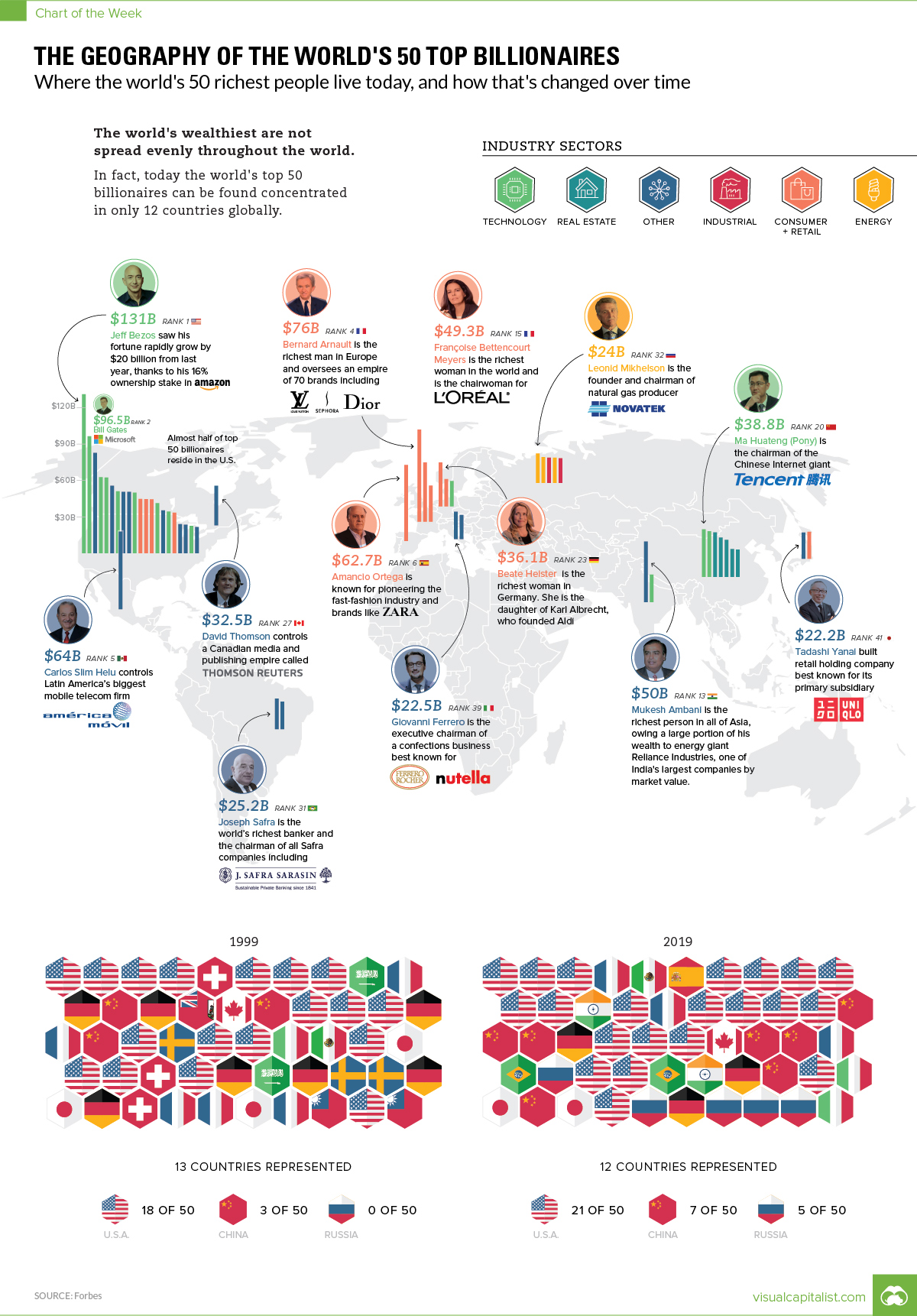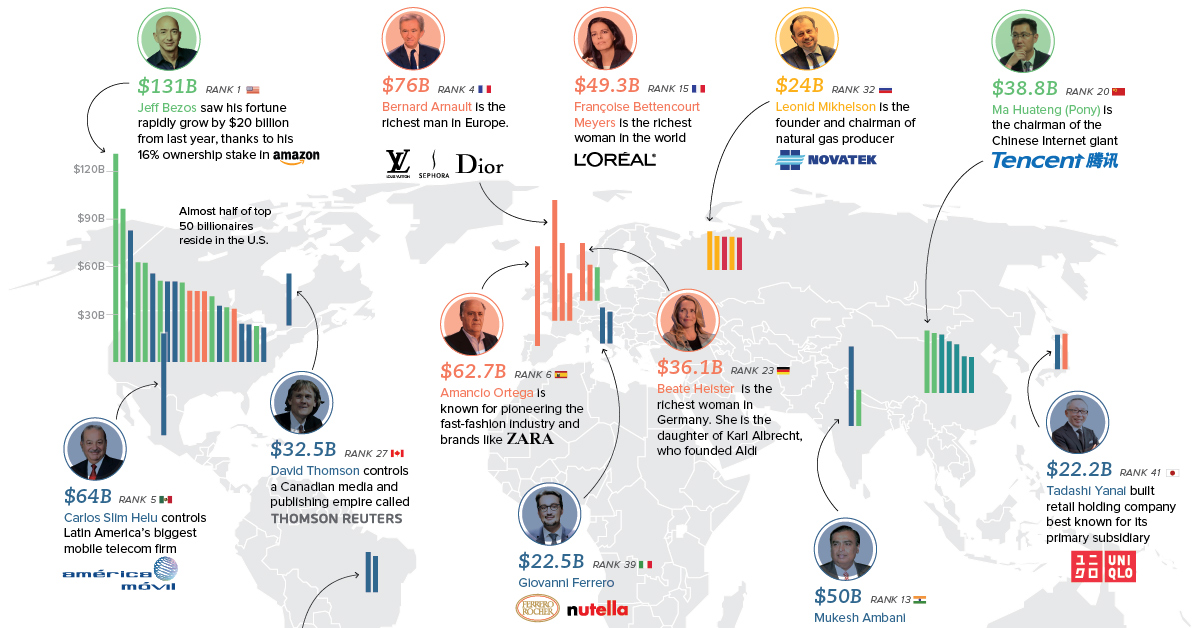Money
The Geography of the World’s 50 Top Billionaires

The Geography of the World’s 50 Top Billionaires
The business world has undergone considerable change in the last two decades.
While some fortunes are always reliably passed on to their respective heirs and heiresses, there are also entirely new industries that rise out of nowhere to shape the landscape of global wealth.
As the wealth landscape shifts, so does its geographical distribution.
The 2019 List of Billionaires
Today’s chart uses data from the most recent edition of the Forbes Billionaires List to map the distribution of the world’s richest people, and then compare that to data from 20 years prior.
We’ll start here by looking at the most recent data from 2019:
| Rank | Name | Net Worth ($B) | Citizenship | Industry |
|---|---|---|---|---|
| #1 | Jeff Bezos | 131 | 🇺🇸 USA | Tech, eCommerce |
| #2 | Bill Gates | 96.5 | 🇺🇸 USA | Tech |
| #3 | Warren Buffett | 82.5 | 🇺🇸 USA | Investments |
| #4 | Bernard Arnault | 76 | 🇫🇷 France | Luxury Goods, Cosmetics |
| #5 | Carlos Slim Helu | 64 | 🇲🇽 Mexico | Telecommunications |
| #6 | Amancio Ortega | 62.7 | 🇪🇸 Spain | Apparel |
| #7 | Larry Ellison | 62.5 | 🇺🇸 USA | Tech |
| #8 | Mark Zuckerberg | 62.3 | 🇺🇸 USA | Tech |
| #9 | Michael Bloomberg | 55.5 | 🇺🇸 USA | Media |
| #10 | Larry Page | 50.8 | 🇺🇸 USA | Tech |
| #11 | Charles Koch | 50.5 | 🇺🇸 USA | Diversified |
| #12 | David Koch | 50.5 | 🇺🇸 USA | Diversified |
| #13 | Mukesh Ambani | 50 | 🇮🇳 India | Oil & Gas, Telecoms |
| #14 | Sergey Brin | 49.8 | 🇺🇸 USA | Tech |
| #15 | Francoise Bettencourt | 49.3 | 🇫🇷 France | Cosmetics |
| #16 | Jim Walton | 44.6 | 🇺🇸 USA | Retail |
| #17 | Alice Walton | 44.4 | 🇺🇸 USA | Retail, Art |
| #18 | Rob Walton | 44.3 | 🇺🇸 USA | Retail |
| #19 | Steve Ballmer | 41.2 | 🇺🇸 USA | Tech |
| #20 | Ma Huateng (Pony) | 38.8 | 🇨🇳 China | Tech |
| #21 | Jack Ma | 37.3 | 🇨🇳 China | Tech, eCommerce |
| #22 | Hui Ka Yan | 36.2 | 🇨🇳 China | Real Estate |
| #23 | Beate Heister & Karl Albrecht Jr. | 36.1 | 🇩🇪 Germany | Retail |
| #24 | Sheldon Adelson | 35.1 | 🇺🇸 USA | Casinos |
| #25 | Michael Dell | 34.3 | 🇺🇸 USA | Tech |
| #26 | Phil Knight | 33.4 | 🇺🇸 USA | Apparel |
| #27 | David Thomson | 32.5 | 🇨🇦 Canada | Media |
| #28 | Li Ka-shing | 31.7 | 🇨🇳 China | Developer |
| #29 | Lee Shau Kee | 30.1 | 🇨🇳 China | Developer |
| #30 | François Pinault | 29.7 | 🇫🇷 France | Luxury Goods |
| #31 | Joseph Safra | 25.2 | 🇧🇷 Brazil | Diversified |
| #32 | Leonid Mikhelson | 24 | 🇷🇺 Russia | Oil & Gas |
| #33 | Jacqueline Mars | 23.4 | 🇺🇸 USA | Food |
| #34 | John Mars | 23.9 | 🇺🇸 USA | Food |
| #35 | Jorge Paulo Lemann | 22.8 | 🇧🇷 Brazil | Diversified |
| #36 | Azim Premji | 22.6 | 🇮🇳 India | Tech |
| #37 | Dieter Schwarz | 22.6 | 🇩🇪 Germany | Retail |
| #38 | Wang Jianlin | 22.6 | 🇨🇳 China | Real Estate |
| #39 | Giovanni Ferrero | 22.4 | 🇮🇹 Italy | Food |
| #40 | Elon Musk | 22.4 | 🇺🇸 USA | Automotive, Tech |
| #41 | Tadashi Yanai | 22.2 | 🇯🇵 Japan | Apparel |
| #42 | Yang Huiyan | 22.1 | 🇨🇳 China | Real Estate |
| #43 | Masayoshi Son | 21.6 | 🇯🇵 Japan | Banking, Investments |
| #44 | Jim Simons | 21.5 | 🇺🇸 USA | Investments |
| #45 | Vladimir Lisin | 21.3 | 🇷🇺 Russia | Steel, Transportation |
| #46 | Susanne Klatten | 21 | 🇩🇪 Germany | Automotive, Pharma |
| #47 | Vagit Alekperov | 20.7 | 🇷🇺 Russia | Oil & Gas |
| #48 | Alexey Mordashov | 20.5 | 🇷🇺 Russia | Steel, Investments |
| #49 | Gennady Timchenko | 20.1 | 🇷🇺 Russia | Oil & Gas |
| #50 | Leonardo Del Vecchio | 19.8 | 🇮🇹 Italy | Eyewear |
The most recent billionaires list features Jeff Bezos at the top with $131 billion, although it’s likely his recent divorce announcement will provide an upcoming shakeup to the Bezos Empire.
Bezos is just one of 21 Americans that find themselves in the top 50 list, which means that 42% of the world’s top billionaires hail from the United States.
Billionaire Geography Over Time
If we compare the top 50 list to that from 1999, it’s interesting to see what has changed over time in terms of geographical distribution.
Here’s the distribution of top countries on both lists, compared:
| Citizenship | Top Billionaires (1999) | Top Billionaires (2019) | Change |
|---|---|---|---|
| 🇷🇺 Russia | 0 | 5 | +5 |
| 🇨🇳 China | 3 | 7 | +4 |
| 🇺🇸 United States | 18 | 21 | +3 |
| 🇧🇷 Brazil | 0 | 2 | +2 |
| 🇮🇳 India | 0 | 2 | +2 |
| 🇮🇹 Italy | 1 | 2 | +1 |
| 🇪🇸 Spain | 0 | 1 | +1 |
| 🇲🇽 Mexico | 1 | 1 | 0 |
| 🇨🇦 Canada | 1 | 1 | 0 |
| 🇧🇲 Bermuda | 1 | 0 | -1 |
| 🇯🇵 Japan | 3 | 2 | -1 |
| 🇫🇷 France | 5 | 3 | -2 |
| 🇸🇦 Saudi Arabia | 2 | 0 | -2 |
| 🇹🇼 Taiwan | 2 | 0 | -2 |
| 🇸🇪 Sweden | 3 | 0 | -3 |
| 🇨🇭Switzerland | 3 | 0 | -3 |
| 🇩🇪 Germany | 7 | 3 | -4 |
In the last 20 years, Russia and China have stockpiled the most top billionaires, adding five and four to the top 50 list respectively. The United States added three, going from 18 to 21 billionaires over the timeframe.
On the other end of the spectrum, Germany, Sweden, and Switzerland have lost the most billionaires from the top 50 ranking.
Money
Charted: Which City Has the Most Billionaires in 2024?
Just two countries account for half of the top 20 cities with the most billionaires. And the majority of the other half are found in Asia.

Charted: Which Country Has the Most Billionaires in 2024?
This was originally posted on our Voronoi app. Download the app for free on iOS or Android and discover incredible data-driven charts from a variety of trusted sources.
Some cities seem to attract the rich. Take New York City for example, which has 340,000 high-net-worth residents with investable assets of more than $1 million.
But there’s a vast difference between being a millionaire and a billionaire. So where do the richest of them all live?
Using data from the Hurun Global Rich List 2024, we rank the top 20 cities with the highest number of billionaires in 2024.
A caveat to these rich lists: sources often vary on figures and exact rankings. For example, in last year’s reports, Forbes had New York as the city with the most billionaires, while the Hurun Global Rich List placed Beijing at the top spot.
Ranked: Top 20 Cities with the Most Billionaires in 2024
The Chinese economy’s doldrums over the course of the past year have affected its ultra-wealthy residents in key cities.
Beijing, the city with the most billionaires in 2023, has not only ceded its spot to New York, but has dropped to #4, overtaken by London and Mumbai.
| Rank | City | Billionaires | Rank Change YoY |
|---|---|---|---|
| 1 | 🇺🇸 New York | 119 | +1 |
| 2 | 🇬🇧 London | 97 | +3 |
| 3 | 🇮🇳 Mumbai | 92 | +4 |
| 4 | 🇨🇳 Beijing | 91 | -3 |
| 5 | 🇨🇳 Shanghai | 87 | -2 |
| 6 | 🇨🇳 Shenzhen | 84 | -2 |
| 7 | 🇭🇰 Hong Kong | 65 | -1 |
| 8 | 🇷🇺 Moscow | 59 | No Change |
| 9 | 🇮🇳 New Delhi | 57 | +6 |
| 10 | 🇺🇸 San Francisco | 52 | No Change |
| 11 | 🇹🇭 Bangkok | 49 | +2 |
| 12 | 🇹🇼 Taipei | 45 | +2 |
| 13 | 🇫🇷 Paris | 44 | -2 |
| 14 | 🇨🇳 Hangzhou | 43 | -5 |
| 15 | 🇸🇬 Singapore | 42 | New to Top 20 |
| 16 | 🇨🇳 Guangzhou | 39 | -4 |
| 17T | 🇮🇩 Jakarta | 37 | +1 |
| 17T | 🇧🇷 Sao Paulo | 37 | No Change |
| 19T | 🇺🇸 Los Angeles | 31 | No Change |
| 19T | 🇰🇷 Seoul | 31 | -3 |
In fact all Chinese cities on the top 20 list have lost billionaires between 2023–24. Consequently, they’ve all lost ranking spots as well, with Hangzhou seeing the biggest slide (-5) in the top 20.
Where China lost, all other Asian cities—except Seoul—in the top 20 have gained ranks. Indian cities lead the way, with New Delhi (+6) and Mumbai (+3) having climbed the most.
At a country level, China and the U.S combine to make up half of the cities in the top 20. They are also home to about half of the world’s 3,200 billionaire population.
In other news of note: Hurun officially counts Taylor Swift as a billionaire, estimating her net worth at $1.2 billion.
-

 Brands6 days ago
Brands6 days agoHow Tech Logos Have Evolved Over Time
-

 Demographics2 weeks ago
Demographics2 weeks agoThe Smallest Gender Wage Gaps in OECD Countries
-

 Economy2 weeks ago
Economy2 weeks agoWhere U.S. Inflation Hit the Hardest in March 2024
-

 Green2 weeks ago
Green2 weeks agoTop Countries By Forest Growth Since 2001
-

 United States2 weeks ago
United States2 weeks agoRanked: The Largest U.S. Corporations by Number of Employees
-

 Maps2 weeks ago
Maps2 weeks agoThe Largest Earthquakes in the New York Area (1970-2024)
-

 Green2 weeks ago
Green2 weeks agoRanked: The Countries With the Most Air Pollution in 2023
-

 Green2 weeks ago
Green2 weeks agoRanking the Top 15 Countries by Carbon Tax Revenue















